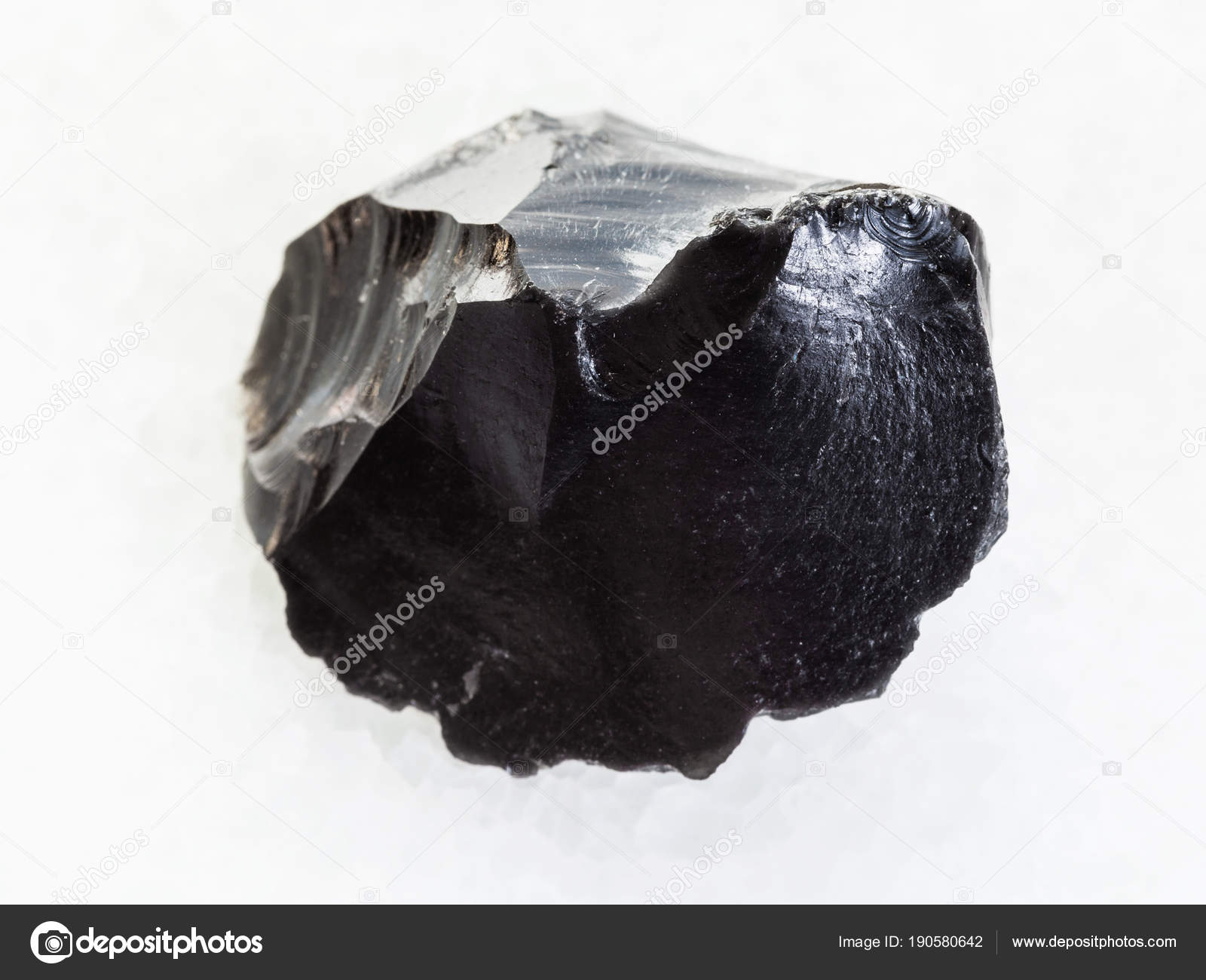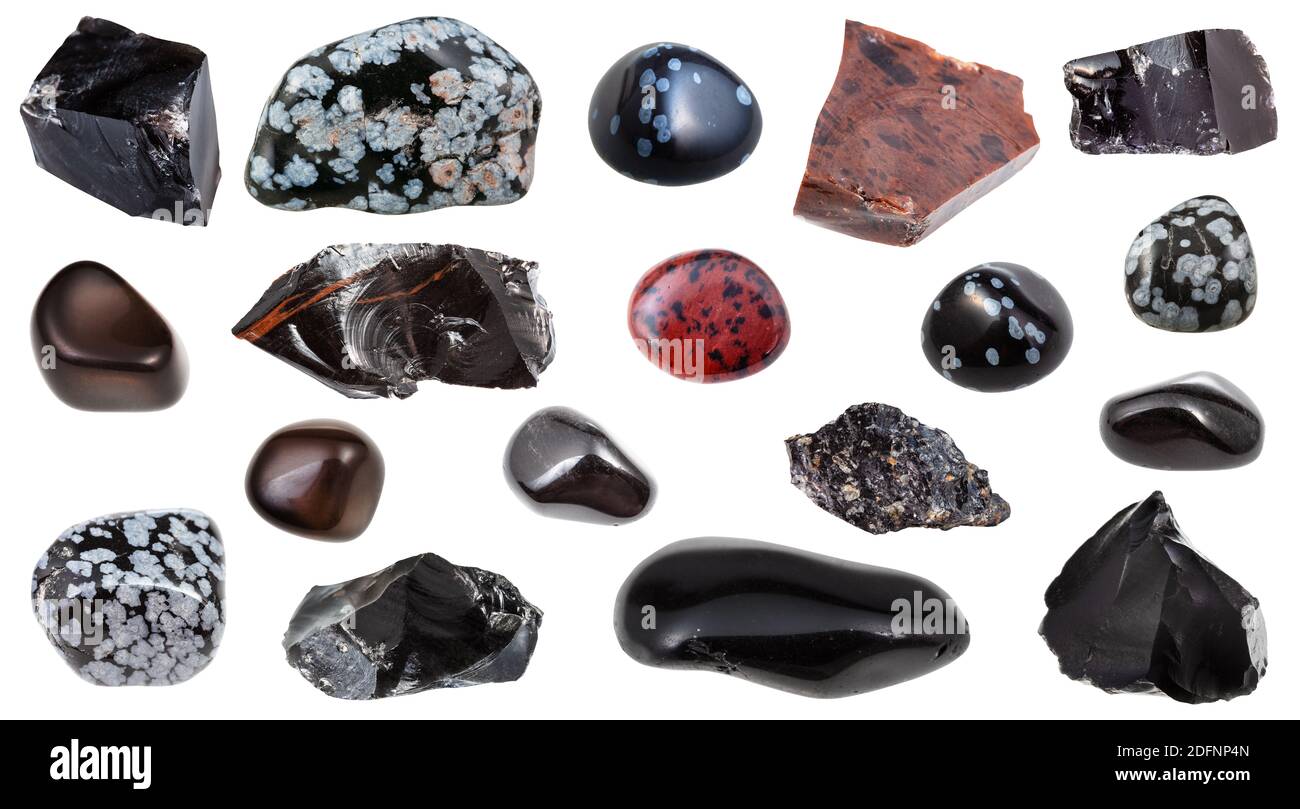Obsidian is natural volcanic glass that forms from highly explosive eruptions. Glass cools so quickly that it doesn’t have time for crystals to form, although in some instances some minor amounts of crystals may be seen. Although obsidian is usually associated with highly explosive volcanoes, which normally produce light colored rocks that are very porous (like pumice), obsidian is typically dark colored – most often black. There are several varieties of obsidian:

Black obsidian: Typical obsidian is black. However, when cut thin, as in slabs used for cabochons, it is often translucent.
Obsidian is a naturally occurring volcanic glass. It is formed during the eruption of felsic lavas, which are distinguished by having high concentrations of the chemical element silica. Because of their high silica content, felsic lavas do not behave like the mafic, or silica-poor, lavas we see on the island of Hawaii. Obsidian, igneous rock occurring as a natural glass formed by the rapid cooling of viscous lava from volcanoes. Obsidian is extremely rich in silica (about 65 to 80 percent), is low in water, and has a chemical composition similar to rhyolite. Obsidian has a glassy lustre and is slightly harder. Obsidian: I don't know if you've ever seen a volcano erupt, but it happens very quickly. The magma or melted rock that comes out of a volcano sometimes cools and hardens very, very quickly too. When you go from a liquid to a solid this fast, you don't have time to form crystals. Instead, you turn into glass.
Double flow obsidian: Obsidian is the result of molten glass flowing down the side of the volcano. Occasionally, swirled patterns of different colors, such as black and white, may be seen. This is called double flow obsidian. It may be the result of two different flows with different compositions, which were laid on top of each other. Then, the layers slipped down the side of the volcano while still hot and were swirled together.
Mahogany: A common form of obsidian has black and reddish-brown color in it. This reddish brown is called mahogany obsidian.
Snowflake and fireworks obsidian: Because volcanic glass is slightly unstable, sometimes it will start to crystallize over time. This crystallization is not uniform, but rather forms at nucleation points. This produces small snowflake or starburst patterns, creating snowflake obsidian or fireworks obsidian.
Rainbow obsidian: Rainbow obsidian is an iridescent combination of multiple colors of glass.
Sheen: Sheen obsidian has small inclusions of metals that cause an iridescent sheen on the surface. There are different types of sheen – gold, silver and fire (with hematite inclusions) are popular.
Obsidian can be a little difficult to work with. It has conchoidal fracture, which is a curved fracture pattern, and as such it is commonly seen as a stone used in making arrowheads and spears. This also means that it can chip relatively easily, so it is advised to use caution when cutting this stone. Also remember, it is glass, and small shards of it can end up in the skin f you are not careful.
Showing all 2 results
What Is An Obsidian
Obsidian is natural volcanic glass that forms from highly explosive eruptions. Glass cools so quickly that it doesn’t have time for crystals to form, although in some instances some minor amounts of crystals may be seen. Although obsidian is usually associated with highly explosive volcanoes, which normally produce light colored rocks that are very porous (like pumice), obsidian is typically dark colored – most often black. There are several varieties of obsidian:


Black obsidian: Typical obsidian is black. However, when cut thin, as in slabs used for cabochons, it is often translucent.
Double flow obsidian: Obsidian is the result of molten glass flowing down the side of the volcano. Occasionally, swirled patterns of different colors, such as black and white, may be seen. This is called double flow obsidian. It may be the result of two different flows with different compositions, which were laid on top of each other. Then, the layers slipped down the side of the volcano while still hot and were swirled together.
Mahogany: A common form of obsidian has black and reddish-brown color in it. This reddish brown is called mahogany obsidian.
Snowflake and fireworks obsidian: Because volcanic glass is slightly unstable, sometimes it will start to crystallize over time. This crystallization is not uniform, but rather forms at nucleation points. This produces small snowflake or starburst patterns, creating snowflake obsidian or fireworks obsidian.
Rainbow obsidian: Rainbow obsidian is an iridescent combination of multiple colors of glass.

Sheen: Sheen obsidian has small inclusions of metals that cause an iridescent sheen on the surface. There are different types of sheen – gold, silver and fire (with hematite inclusions) are popular.
Volcanic Glass Obsidian Description
Obsidian can be a little difficult to work with. It has conchoidal fracture, which is a curved fracture pattern, and as such it is commonly seen as a stone used in making arrowheads and spears. This also means that it can chip relatively easily, so it is advised to use caution when cutting this stone. Also remember, it is glass, and small shards of it can end up in the skin f you are not careful.
Obsidian Glass Volcano Vape

Showing all 2 results
